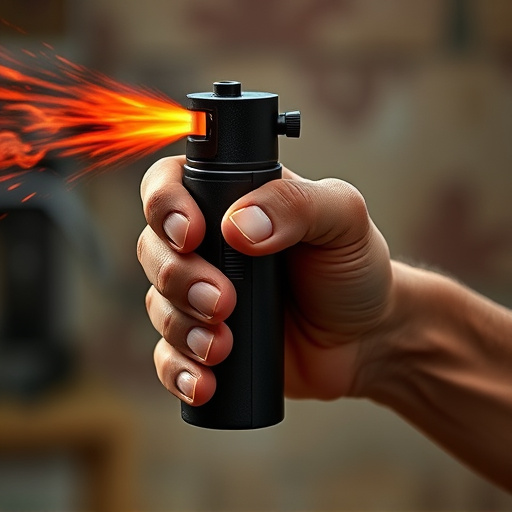Proper storing of pepper spray is vital for maximizing its effectiveness as a civilian protection tool. Keep it cool, dry, and away from direct sunlight or heat sources. Store out of reach from children and pets, regularly check expiration dates and spray mechanisms, and maintain ideal storage conditions (room temperature, protected from light) to ensure responsible use and maximize impact in self-defense scenarios.
In today’s world, civilians are increasingly looking for effective personal defense tools. One of the most popular choices is pepper spray, known for its rapid effectiveness in neutralizing attackers. This article delves into the world of civilian protection with an emphasis on understanding and storing pepper spray for maximum effectiveness. We’ll explore the active ingredients, safety measures, best storage practices, and real-world use cases, empowering individuals to make informed decisions about their safety.
- Understanding Pepper Spray: Active Ingredients and Safety Measures
- Storing Pepper Spray for Optimal Performance: Tips and Best Practices
- Effective Use Cases: Pepper Spray as a Civilian Self-Defense Tool
Understanding Pepper Spray: Active Ingredients and Safety Measures
Pepper spray, a popular civilian protection tool, is designed to disable an assailant temporarily, providing users with an opportunity to escape or seek help. Its primary active ingredient, capsaicin, is derived from chili peppers and triggers a burning sensation in the eyes, nose, and throat when sprayed. This irritates the respiratory system, causing the individual to cough, sneeze, and experience difficulty breathing, effectively disorienting them for a short period.
Proper storage of pepper spray is crucial for maintaining its maximum effectiveness. Users should keep it in a cool, dry place away from direct sunlight and heat sources. It’s recommended to store pepper spray out of reach of children and pets. Additionally, regular maintenance, such as checking the expiration date and testing the spray mechanism periodically, ensures that the device functions correctly when needed. Understanding and adhering to safety measures is essential for responsible use, minimizing risks, and maximizing the spray’s impact in self-defense scenarios.
Storing Pepper Spray for Optimal Performance: Tips and Best Practices
Storing pepper spray properly is paramount to ensure its maximum effectiveness when needed. Keep it in a cool, dry place away from direct sunlight or extreme temperatures. Extreme heat can degrade the chemical composition, reducing its potency over time. Similarly, cold environments may cause the canister to freeze, potentially damaging the internal mechanism and affecting its performance. Ideal storage conditions mimic those found in most homes: around room temperature, protected from direct light, and out of reach of children or unauthorized individuals.
For optimal performance, consider storing pepper spray in a locked safe or secure cabinet. This adds an extra layer of protection, ensuring it remains untouched until required. Keep the canister in its original packaging if possible, as this provides additional information on usage and expiration dates. Regularly check the spray’s condition, inspecting for any signs of damage, corrosion, or leakage. If you live in a humid area, consider using desiccant packets to absorb moisture, preventing clogs or reduced spray intensity due to water buildup inside the canister.
Effective Use Cases: Pepper Spray as a Civilian Self-Defense Tool
Pepper spray has proven to be an effective civilian self-defense tool, offering a non-lethal means of deterring and incapacitating potential attackers. Its active ingredient, capsaicin, irritates the eyes, nose, and throat, causing temporary disorientation and difficulty breathing, giving users precious time to escape or seek help.
Proper storing of pepper spray is crucial for maintaining its maximum effectiveness. It should be kept in a cool, dry place away from direct sunlight and heat sources. Many experts recommend storing it in a pocket or belt holster, readily accessible yet protected from accidental discharge. Additionally, regularly practicing the use of pepper spray ensures users are comfortable and confident in its deployment during an emergency situation.
Pepper spray is a powerful tool for civilian self-defense, offering a safe and effective means of deterring potential threats. By understanding its active ingredients, practicing proper safety measures, and implementing best practices for storage, individuals can maximize the effectiveness of their pepper spray for personal protection. When used responsibly and in accordance with local laws, pepper spray can be a valuable asset in navigating potentially dangerous situations.
